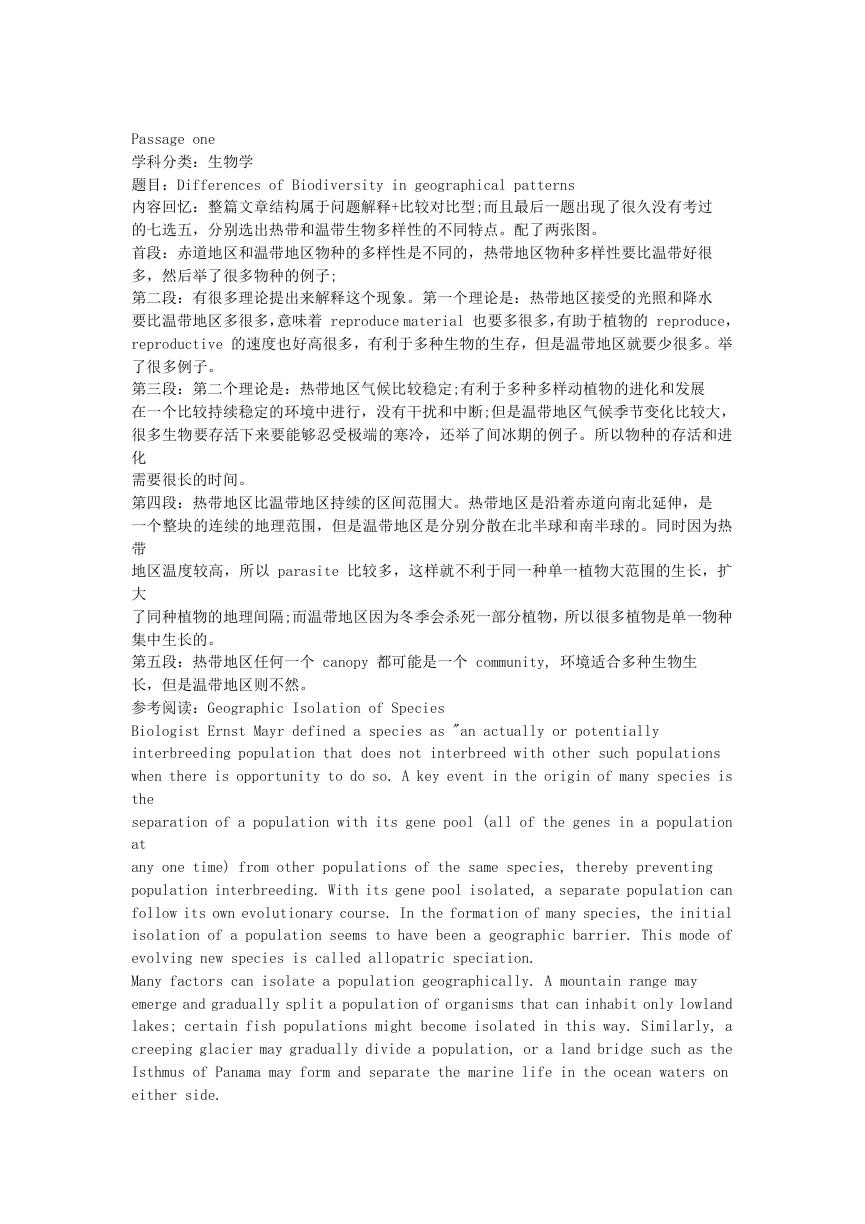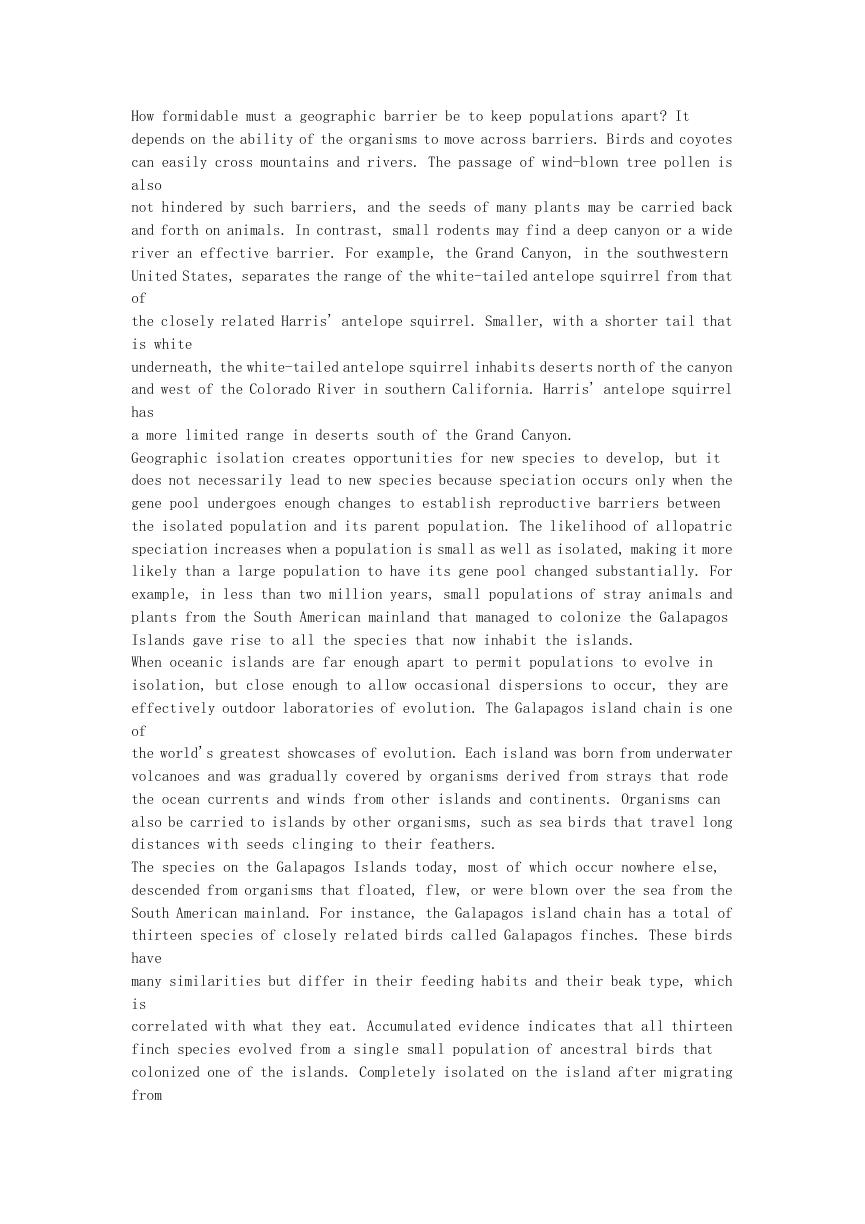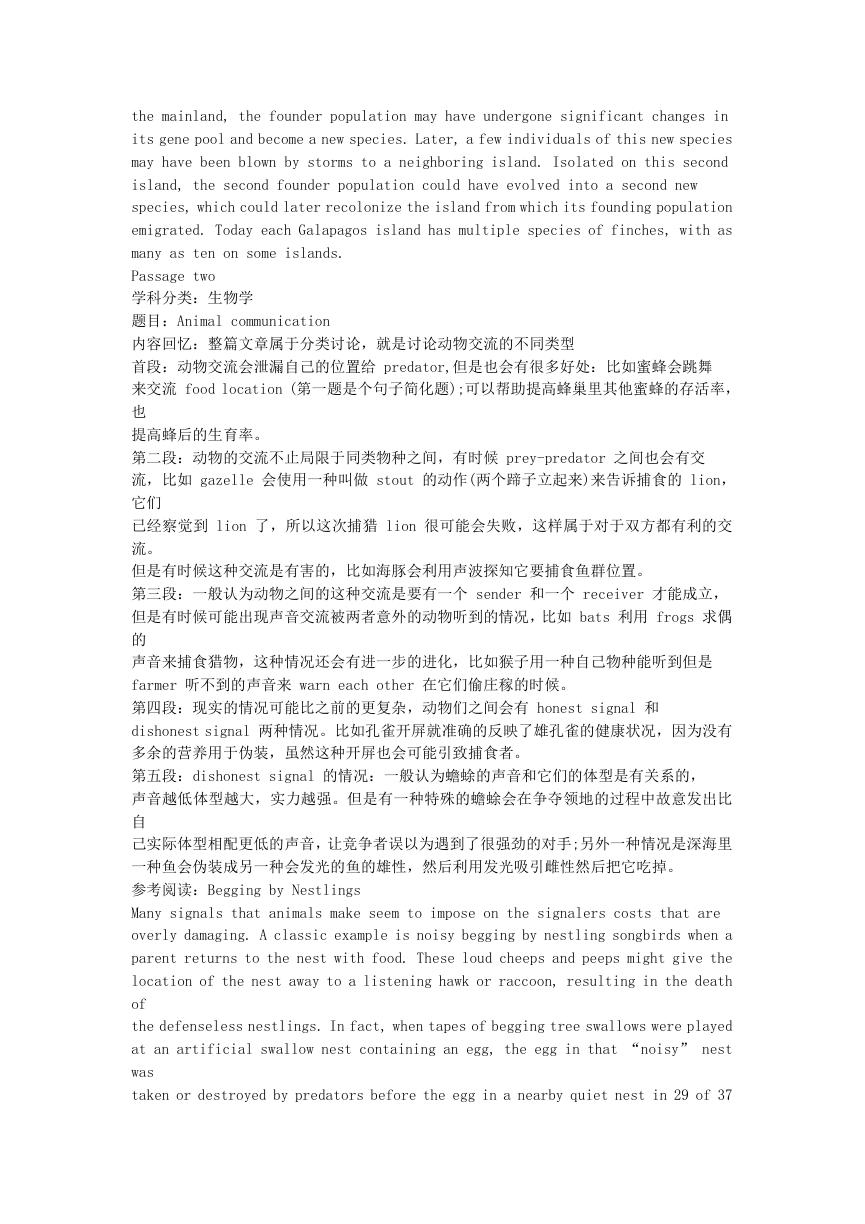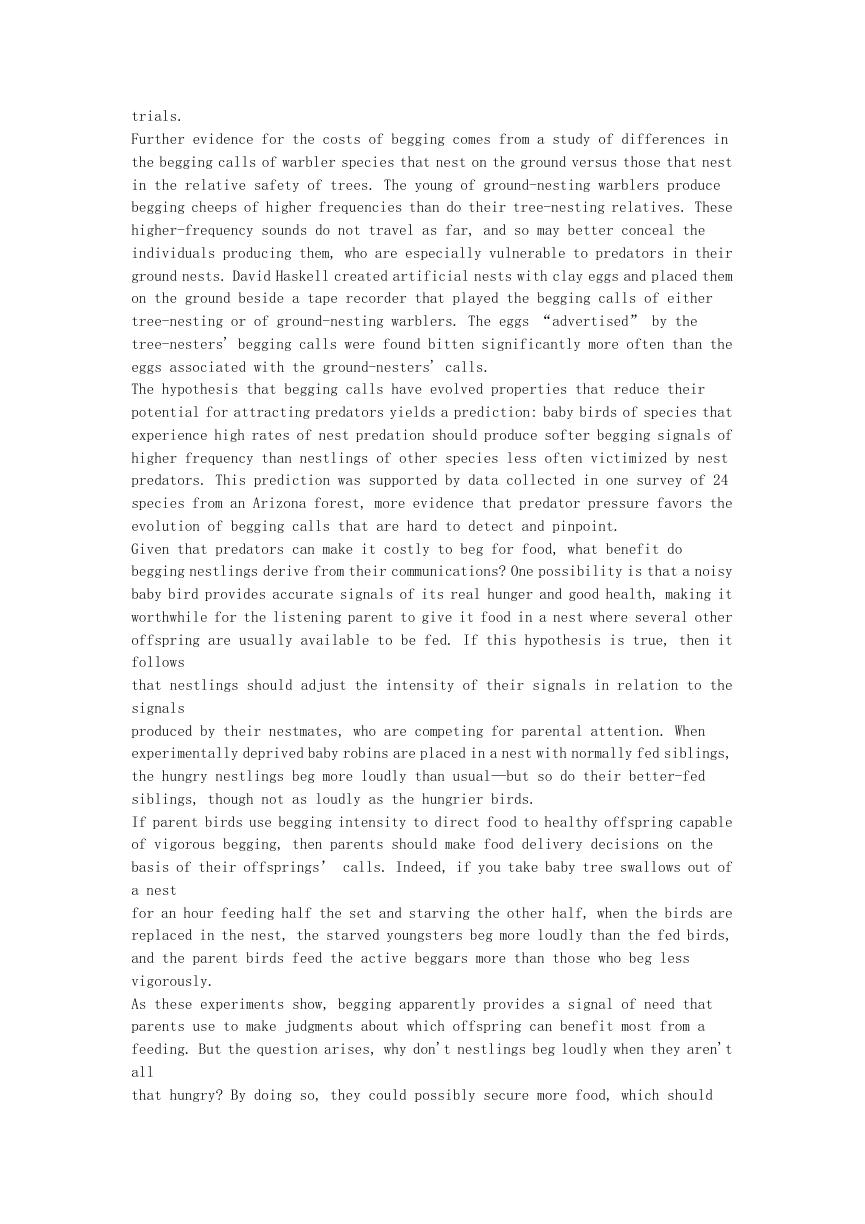2018 年 9 月托福真题回忆及解析
备考是一种经历,也是一种体验。每天进步一点点,基础扎实一点点,通过考试就会更容
易一点点。无忧考网搜集整理了 2018 年 9 月托福真题回忆及解析,希望对大家有所帮助。
2018 年 9 月举行了 5 场考试,时间分别为 9 月 2 日、9 月 8 日、9 月 9 日、9 月 15 日、9
月 16 日。以下内容仅供参考。
9 月 2 日托福口语真题回忆:
Task 1
内容回忆:If universities are given financial support to develop researches, which
one do you think would receive more benefits?
A. To predict weather more accurately.
B. To clean rivers and ocean.
C. To deal with outer space.
参考答案:Personally speaking, I think cleaning rivers and ocean will be the best
option for university to develop researches on. We all know that water plays a
significant role not only in humans’ lives but also for other animals. First off,
we
have to ensure our drinking water is clean, without toxic chemicals or pollutants.
Then, the quality of water is also important for aquatic lives, some of which have
even been driven to extinction due to water pollution. Therefore, the research from
university contributes to the well-being of many livings, and this conduction could,
in some way, motivate more students to concern about the environment condition,
and take actions. So I think it’s meaningful and worthwhile to do this.
Task 2
内容回忆:你觉得交朋友都是一个年龄的好还是不同年龄的好?
参考答案:I firmly believe that making friends with people in different ages is
interesting and beneficial. I myself have lots of friends who are 10 years older
than
me, and also, some friends who are 5 to 10 years younger than me. This can truly
expand my horizon. I mean, with senior friends, I grow up fast, because they are
experienced and sophisticated. Listening to their perspectives about the world let
me be wiser and calmer. On the other hand, young friends are not so mature, but
they are simpler, and always energetic. I often go hiking or try some extreme sports
with them. These activities make my life more wonderful. Plus, I know the world’
s
latest trend from my younger friends.
Task 3
阅读:旧自行车利用计划
听力:女生不同意,有许多学生有自己的车子,并且共享单车学生不想修。
Task 4
阅读:通过听闻或者个人经历来做决定
�
听力:一个人去买一辆已经看好的车,有一个人告诉他车修不好,修理的地方很远,他
就有点不想买了。然后回家问了一个专家,专家说车很好,然后他就买了。
Task 5
问题:女学生的一些画画的工具保管在学校 building 里,学期末了,要求学生今天必
须拿走,否则就会被清理掉
解决方案:
1:顾虑是她住得远不方便提东西,用袋子去装挺多挺麻烦的;
2:是借 lisa 的车,但是她在准备考试不方便打扰她。
Task 6
话题:固定时间睡觉
要点:大猩猩晚上睡觉,一是因为 save energy,二是躲避敌人。
9 月 2 日托福听力真题回忆:
Conversation
Conversation1
话题分类:学术类-论文话题
内容回忆:学生说我要毕业了,break 期间要留在学校写论文,写一天论文很累,能不
能让学校把 gym 开放,我们 break 期间可以使用。Dean 说这个是给大决定。学生说校足
球队篮球队在 break 期间都可以继续使用 gym. Dean 说他们有教练,这样比较安全。Gym
以前从未开放过,这是一个大事情,学校一般不会同意的,要是你们实在想去,可以去镇
上
的,镇上的 gym 还对学生打折。
参考听力:Tpo 12-conversation1
Conversation2
话题分类:工作类
内容回忆:教授一开始看学生说你文章写的很好,现在学校要招一个新的写作 tutor,
你有没有兴趣。学生说,我不是英语专业的,我是生物专业的,这样会不会不好。教授说
你
的写作已经达到了一定水平,所以可以的,没有问题,而且生物学科背景正好可以帮助有
类
似背景的学生。而且这个有培训,先培训然后有一个 mentor 来辅导你,过了 supervising
期了之后你才独立。Susan 去年就在做 tutor, 今年还在做,你可以去问问她,她现在在
图
书馆。
参考听力:Tpo11-conversation2
Conversation3
话题分类:课堂讨论
内容回忆:讨论一个希腊的剧,学生看不懂
参考听力:Tpo39-conversation1
Conversation4
话题分类:咨询类
内容回忆:一个学生活动的彩排和调整时间
参考听力:Tpo16-conversation1
�
Lecture
Lecture1
话题分类:考古学
内容回忆:新石器时代是人们开始驯化动物,培育作物的时代,人们一般认为这个时候
的人吃肉,但是考古发现他们有 grinding tools, 所以研究他们 grind 的是什么物质。
列举
了好几种猜测,重点谈了 flour 的来源和用法。
参考听力:Tpo29-lecture3
Lecture2
话题分类:天文学
内容回忆:讲了 multiple companion-star system 和 binary companion-star
system. 两个系统的共同点和不同点
参考听力:Tpo38-lecture4 too 41-lecture4. Tpo42-lecture2
Lecture3
话题分类:地质学
内容回忆:白垩纪晚期气候变化。海平面上升,全球气温升高,然后下降。探讨了几种
测量方法。isotope 18.
参考听力:Tpo15-lecture2
Lecture4
话题分类:艺术类
内容回忆:liveperformance 是活生生的,面对观众的,只存在于记忆中和历史记录中,
基本上很少有 live performance 在博物馆出现。然后教授转折介绍了一个在博物馆展览
的
live performance。 艺术家和观众面对面坐着沉思。参加的人很多,平均下来每个人坐了
20 分钟。一开始以为这种艺术没有人参加的,后来发现很多人。
参考听力:Tpo24-lecture2 tpo23-lecture4
Lecture5
话题分类:自然科学
内容回忆:某种特殊形态的 glacier
参考听力:Tpo7-lecture4
Lecture6
话题分类:人类学
内容回忆:鼓的进化
参考听力:Tpo7-lecture3 Too 36-lecture2
Lecture7
话题分类:文学类
内容回忆:介绍作家简-奥斯汀
参考听力:Tpo4-lecture2 tpo43-lecture3
Lecture8
话题分类:心理学
内容回忆:群体决策对他人的影响
参考听力:Tpo2-lecture1
9 月 2 日托福阅读真题回忆:
�
Passage one
学科分类:生物学
题目:Differences of Biodiversity in geographical patterns
内容回忆:整篇文章结构属于问题解释+比较对比型;而且最后一题出现了很久没有考过
的七选五,分别选出热带和温带生物多样性的不同特点。配了两张图。
首段:赤道地区和温带地区物种的多样性是不同的,热带地区物种多样性要比温带好很
多,然后举了很多物种的例子;
第二段:有很多理论提出来解释这个现象。第一个理论是:热带地区接受的光照和降水
要比温带地区多很多,意味着 reproduce material 也要多很多,有助于植物的 reproduce,
reproductive 的速度也好高很多,有利于多种生物的生存,但是温带地区就要少很多。举
了很多例子。
第三段:第二个理论是:热带地区气候比较稳定;有利于多种多样动植物的进化和发展
在一个比较持续稳定的环境中进行,没有干扰和中断;但是温带地区气候季节变化比较大,
很多生物要存活下来要能够忍受极端的寒冷,还举了间冰期的例子。所以物种的存活和进
化
需要很长的时间。
第四段:热带地区比温带地区持续的区间范围大。热带地区是沿着赤道向南北延伸,是
一个整块的连续的地理范围,但是温带地区是分别分散在北半球和南半球的。同时因为热
带
地区温度较高,所以 parasite 比较多,这样就不利于同一种单一植物大范围的生长,扩
大
了同种植物的地理间隔;而温带地区因为冬季会杀死一部分植物,所以很多植物是单一物种
集中生长的。
第五段:热带地区任何一个 canopy 都可能是一个 community, 环境适合多种生物生
长,但是温带地区则不然。
参考阅读:Geographic Isolation of Species
Biologist Ernst Mayr defined a species as "an actually or potentially
interbreeding population that does not interbreed with other such populations
when there is opportunity to do so. A key event in the origin of many species is
the
separation of a population with its gene pool (all of the genes in a population
at
any one time) from other populations of the same species, thereby preventing
population interbreeding. With its gene pool isolated, a separate population can
follow its own evolutionary course. In the formation of many species, the initial
isolation of a population seems to have been a geographic barrier. This mode of
evolving new species is called allopatric speciation.
Many factors can isolate a population geographically. A mountain range may
emerge and gradually split a population of organisms that can inhabit only lowland
lakes; certain fish populations might become isolated in this way. Similarly, a
creeping glacier may gradually divide a population, or a land bridge such as the
Isthmus of Panama may form and separate the marine life in the ocean waters on
either side.
�
How formidable must a geographic barrier be to keep populations apart? It
depends on the ability of the organisms to move across barriers. Birds and coyotes
can easily cross mountains and rivers. The passage of wind-blown tree pollen is
also
not hindered by such barriers, and the seeds of many plants may be carried back
and forth on animals. In contrast, small rodents may find a deep canyon or a wide
river an effective barrier. For example, the Grand Canyon, in the southwestern
United States, separates the range of the white-tailed antelope squirrel from that
of
the closely related Harris' antelope squirrel. Smaller, with a shorter tail that
is white
underneath, the white-tailed antelope squirrel inhabits deserts north of the canyon
and west of the Colorado River in southern California. Harris' antelope squirrel
has
a more limited range in deserts south of the Grand Canyon.
Geographic isolation creates opportunities for new species to develop, but it
does not necessarily lead to new species because speciation occurs only when the
gene pool undergoes enough changes to establish reproductive barriers between
the isolated population and its parent population. The likelihood of allopatric
speciation increases when a population is small as well as isolated, making it more
likely than a large population to have its gene pool changed substantially. For
example, in less than two million years, small populations of stray animals and
plants from the South American mainland that managed to colonize the Galapagos
Islands gave rise to all the species that now inhabit the islands.
When oceanic islands are far enough apart to permit populations to evolve in
isolation, but close enough to allow occasional dispersions to occur, they are
effectively outdoor laboratories of evolution. The Galapagos island chain is one
of
the world's greatest showcases of evolution. Each island was born from underwater
volcanoes and was gradually covered by organisms derived from strays that rode
the ocean currents and winds from other islands and continents. Organisms can
also be carried to islands by other organisms, such as sea birds that travel long
distances with seeds clinging to their feathers.
The species on the Galapagos Islands today, most of which occur nowhere else,
descended from organisms that floated, flew, or were blown over the sea from the
South American mainland. For instance, the Galapagos island chain has a total of
thirteen species of closely related birds called Galapagos finches. These birds
have
many similarities but differ in their feeding habits and their beak type, which
is
correlated with what they eat. Accumulated evidence indicates that all thirteen
finch species evolved from a single small population of ancestral birds that
colonized one of the islands. Completely isolated on the island after migrating
from
�
the mainland, the founder population may have undergone significant changes in
its gene pool and become a new species. Later, a few individuals of this new species
may have been blown by storms to a neighboring island. Isolated on this second
island, the second founder population could have evolved into a second new
species, which could later recolonize the island from which its founding population
emigrated. Today each Galapagos island has multiple species of finches, with as
many as ten on some islands.
Passage two
学科分类:生物学
题目:Animal communication
内容回忆:整篇文章属于分类讨论,就是讨论动物交流的不同类型
首段:动物交流会泄漏自己的位置给 predator,但是也会有很多好处:比如蜜蜂会跳舞
来交流 food location (第一题是个句子简化题);可以帮助提高蜂巢里其他蜜蜂的存活率,
也
提高蜂后的生育率。
第二段:动物的交流不止局限于同类物种之间,有时候 prey-predator 之间也会有交
流,比如 gazelle 会使用一种叫做 stout 的动作(两个蹄子立起来)来告诉捕食的 lion,
它们
已经察觉到 lion 了,所以这次捕猎 lion 很可能会失败,这样属于对于双方都有利的交
流。
但是有时候这种交流是有害的,比如海豚会利用声波探知它要捕食鱼群位置。
第三段:一般认为动物之间的这种交流是要有一个 sender 和一个 receiver 才能成立,
但是有时候可能出现声音交流被两者意外的动物听到的情况,比如 bats 利用 frogs 求偶
的
声音来捕食猎物,这种情况还会有进一步的进化,比如猴子用一种自己物种能听到但是
farmer 听不到的声音来 warn each other 在它们偷庄稼的时候。
第四段:现实的情况可能比之前的更复杂,动物们之间会有 honest signal 和
dishonest signal 两种情况。比如孔雀开屏就准确的反映了雄孔雀的健康状况,因为没有
多余的营养用于伪装,虽然这种开屏也会可能引致捕食者。
第五段:dishonest signal 的情况:一般认为蟾蜍的声音和它们的体型是有关系的,
声音越低体型越大,实力越强。但是有一种特殊的蟾蜍会在争夺领地的过程中故意发出比
自
己实际体型相配更低的声音,让竞争者误以为遇到了很强劲的对手;另外一种情况是深海里
一种鱼会伪装成另一种会发光的鱼的雄性,然后利用发光吸引雌性然后把它吃掉。
参考阅读:Begging by Nestlings
Many signals that animals make seem to impose on the signalers costs that are
overly damaging. A classic example is noisy begging by nestling songbirds when a
parent returns to the nest with food. These loud cheeps and peeps might give the
location of the nest away to a listening hawk or raccoon, resulting in the death
of
the defenseless nestlings. In fact, when tapes of begging tree swallows were played
at an artificial swallow nest containing an egg, the egg in that “noisy” nest
was
taken or destroyed by predators before the egg in a nearby quiet nest in 29 of 37
�
trials.
Further evidence for the costs of begging comes from a study of differences in
the begging calls of warbler species that nest on the ground versus those that nest
in the relative safety of trees. The young of ground-nesting warblers produce
begging cheeps of higher frequencies than do their tree-nesting relatives. These
higher-frequency sounds do not travel as far, and so may better conceal the
individuals producing them, who are especially vulnerable to predators in their
ground nests. David Haskell created artificial nests with clay eggs and placed them
on the ground beside a tape recorder that played the begging calls of either
tree-nesting or of ground-nesting warblers. The eggs “advertised” by the
tree-nesters' begging calls were found bitten significantly more often than the
eggs associated with the ground-nesters' calls.
The hypothesis that begging calls have evolved properties that reduce their
potential for attracting predators yields a prediction: baby birds of species that
experience high rates of nest predation should produce softer begging signals of
higher frequency than nestlings of other species less often victimized by nest
predators. This prediction was supported by data collected in one survey of 24
species from an Arizona forest, more evidence that predator pressure favors the
evolution of begging calls that are hard to detect and pinpoint.
Given that predators can make it costly to beg for food, what benefit do
begging nestlings derive from their communications? One possibility is that a noisy
baby bird provides accurate signals of its real hunger and good health, making it
worthwhile for the listening parent to give it food in a nest where several other
offspring are usually available to be fed. If this hypothesis is true, then it
follows
that nestlings should adjust the intensity of their signals in relation to the
signals
produced by their nestmates, who are competing for parental attention. When
experimentally deprived baby robins are placed in a nest with normally fed siblings,
the hungry nestlings beg more loudly than usual—but so do their better-fed
siblings, though not as loudly as the hungrier birds.
If parent birds use begging intensity to direct food to healthy offspring capable
of vigorous begging, then parents should make food delivery decisions on the
basis of their offsprings’ calls. Indeed, if you take baby tree swallows out of
a nest
for an hour feeding half the set and starving the other half, when the birds are
replaced in the nest, the starved youngsters beg more loudly than the fed birds,
and the parent birds feed the active beggars more than those who beg less
vigorously.
As these experiments show, begging apparently provides a signal of need that
parents use to make judgments about which offspring can benefit most from a
feeding. But the question arises, why don't nestlings beg loudly when they aren't
all
that hungry? By doing so, they could possibly secure more food, which should
�
result in more rapid growth or larger size, either of which is advantageous. The
answer lies apparently not in the increased energy costs of exaggerated begging
—
such energy costs are small relative to the potential gain in calories—but rather
in
the damage that any successful cheater would do to its siblings, which share genes
with one another. An individual's success in propagating his or her genes can be
affected by more than just his or her own personal reproductive success. Because
close relatives have many of the same genes, animals that harm their close relatives
may in effect be destroying some of their own genes. Therefore, a begging nestling
that secures food at the expense of its siblings might actually leave behind fewer
copies of its genes overall than it might otherwise.
Passage three
学科分类:历史学
题目:Eli Terry’s clocks
内容回忆:以时间顺序介绍 Eli Terry 革新表的历史历程
第一段:钟表一开始属于 luxury 的物品,不是普通人可以有的,然后大段介绍钟表手
工制作的过程,非常精细(考了否定事实信息题)。一年估计一个师傅只能制作 12-20 个钟。
第二段:Eli Terry 受到德国制造业的启发,革新了过程,使用木头而不是金属来制作
零件,提高了制作效率,钟表的精确度虽然下降,但是也使价格下降到了一个大家都可以
接
受的范围。然后他受到军事思想的启发使用了流水化作业,建造了 water-powered 的工厂,
提高了整体制作的数量,使得中产阶级也能享受由钟表带来的社会地位。
第三段:虽然革新,但是还是运输不便,不能使大家都享受,很多人买了表之后要自己
额外定做一个外壳。然后 1816 年进一步革新,使得钟表的受众范围进一步扩大,peddlers
也能够售卖。Eli Terry 还为此申请了一个专利,但是专利受到了大量仿制和侵权。
第五段: Terry 为了应对侵权,要进一步改革表,他和一个来自其他机构的人一起革
新制作了一种新的表。然后是新表的工艺。原先的木质框架用玻璃取代。虽然在工艺制造
上
的独创性并没有得到肯定,但是它引领了钟表的时尚潮流,确立了一种新的风潮。
参考阅读:The Invention of the Mechanical Clock
In Europe, before the introduction of the mechanical clock, people told time by
sun (using, for example, shadow sticks or sun dials) and water clocks. Sun clocks
worked, of course, only on clear days; water clocks misbehaved when the
temperature fell toward freezing, to say nothing of long-run drift as the result
of
sedimentation and clogging. Both these devices worked well in sunny climates; but
in northern Europe the sun may be hidden by clouds for weeks at a time, while
temperatures vary not only seasonally but from day to night.
Medieval Europe gave new importance to reliable time. The Catholic Church
had its seven daily prayers, one of which was at night, requiring an alarm
arrangement to waken monks before dawn. And then the new cities and towns,
squeezed by their walls, had to know and order time in order to organize collective
activity and ration space. They set a time to go to work, to open the market, to
�
















 2023年江西萍乡中考道德与法治真题及答案.doc
2023年江西萍乡中考道德与法治真题及答案.doc 2012年重庆南川中考生物真题及答案.doc
2012年重庆南川中考生物真题及答案.doc 2013年江西师范大学地理学综合及文艺理论基础考研真题.doc
2013年江西师范大学地理学综合及文艺理论基础考研真题.doc 2020年四川甘孜小升初语文真题及答案I卷.doc
2020年四川甘孜小升初语文真题及答案I卷.doc 2020年注册岩土工程师专业基础考试真题及答案.doc
2020年注册岩土工程师专业基础考试真题及答案.doc 2023-2024学年福建省厦门市九年级上学期数学月考试题及答案.doc
2023-2024学年福建省厦门市九年级上学期数学月考试题及答案.doc 2021-2022学年辽宁省沈阳市大东区九年级上学期语文期末试题及答案.doc
2021-2022学年辽宁省沈阳市大东区九年级上学期语文期末试题及答案.doc 2022-2023学年北京东城区初三第一学期物理期末试卷及答案.doc
2022-2023学年北京东城区初三第一学期物理期末试卷及答案.doc 2018上半年江西教师资格初中地理学科知识与教学能力真题及答案.doc
2018上半年江西教师资格初中地理学科知识与教学能力真题及答案.doc 2012年河北国家公务员申论考试真题及答案-省级.doc
2012年河北国家公务员申论考试真题及答案-省级.doc 2020-2021学年江苏省扬州市江都区邵樊片九年级上学期数学第一次质量检测试题及答案.doc
2020-2021学年江苏省扬州市江都区邵樊片九年级上学期数学第一次质量检测试题及答案.doc 2022下半年黑龙江教师资格证中学综合素质真题及答案.doc
2022下半年黑龙江教师资格证中学综合素质真题及答案.doc